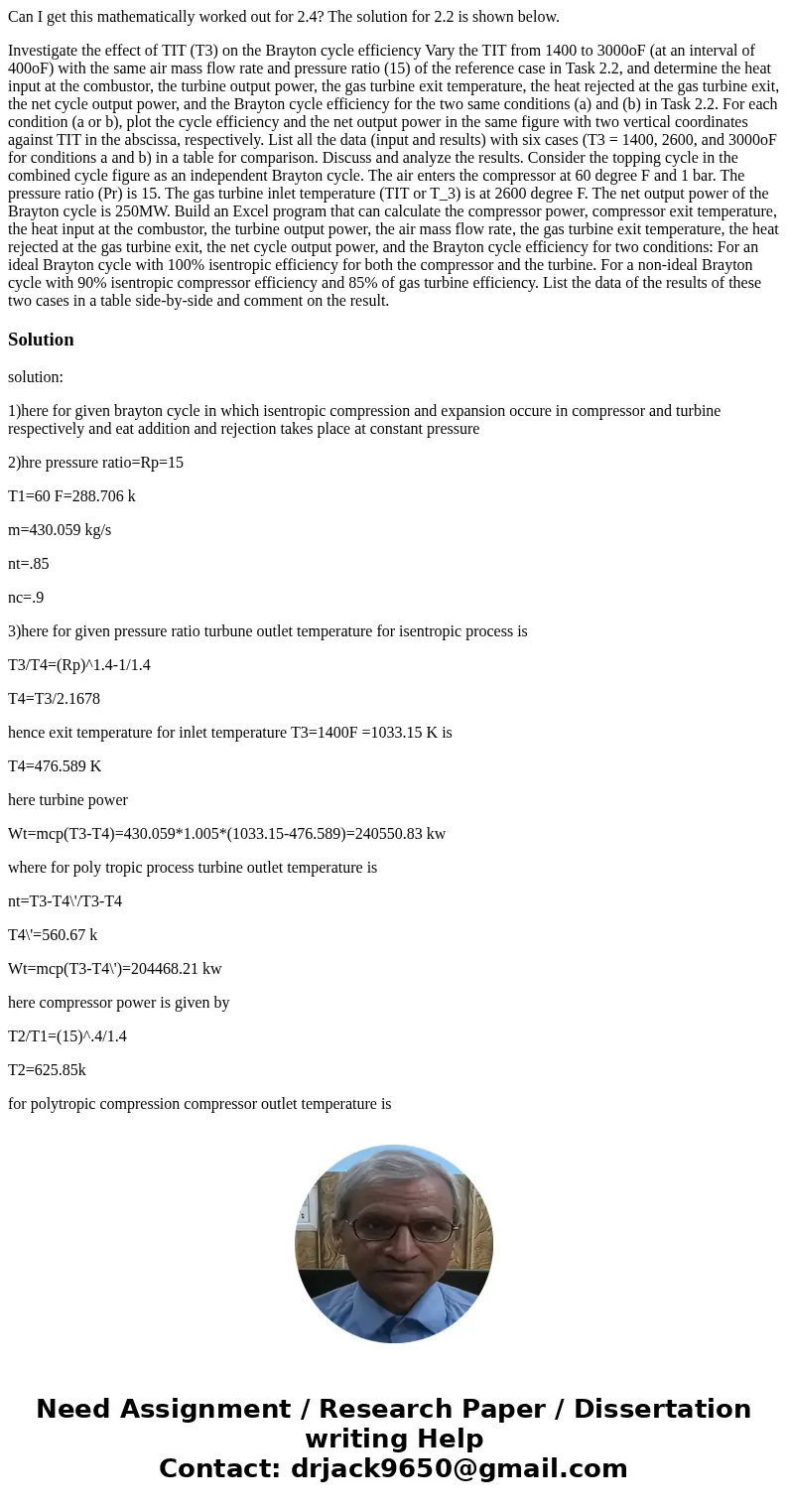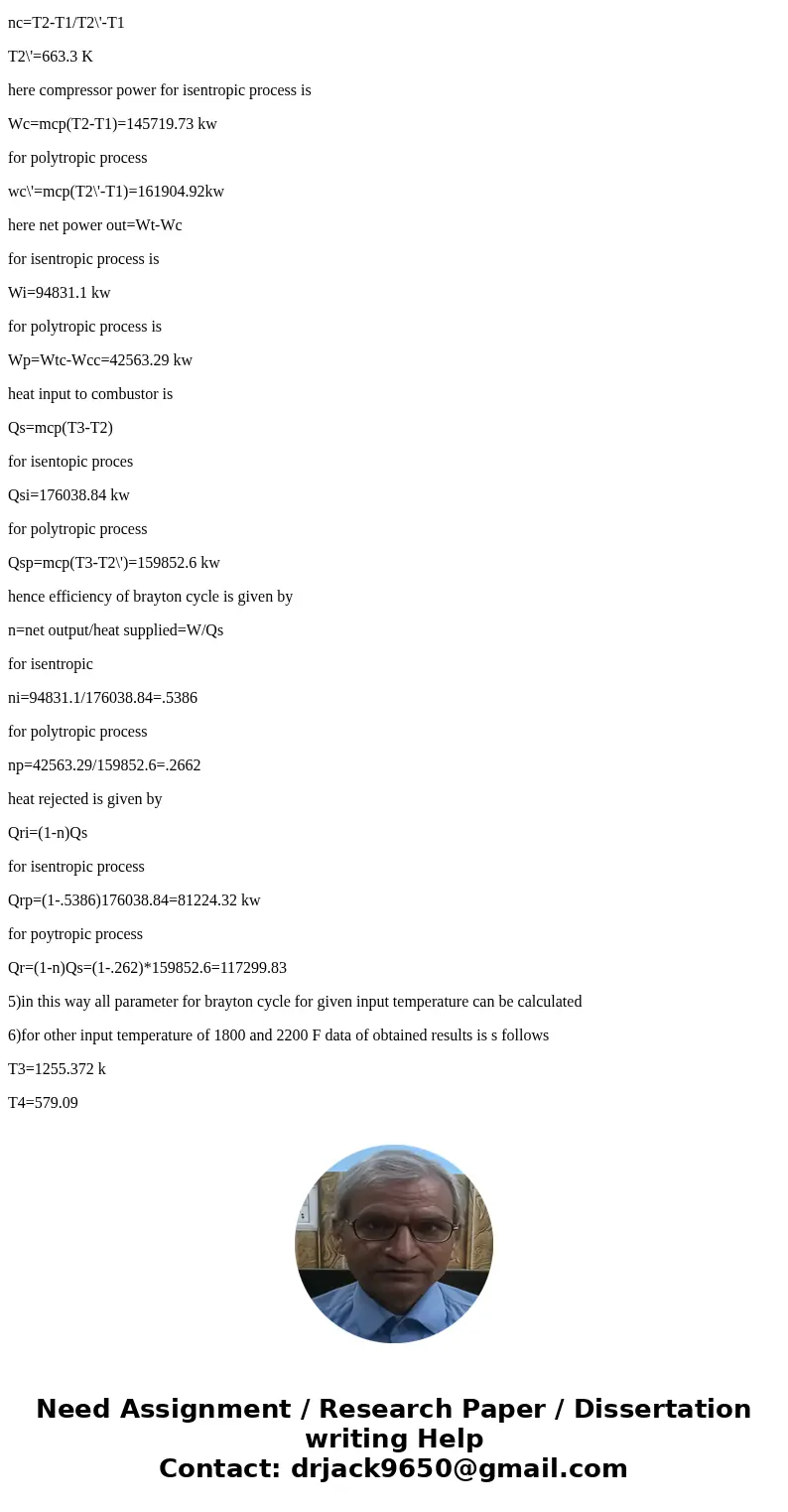Can I get this mathematically worked out for 24 The solution
Can I get this mathematically worked out for 2.4? The solution for 2.2 is shown below.
Investigate the effect of TIT (T3) on the Brayton cycle efficiency Vary the TIT from 1400 to 3000oF (at an interval of 400oF) with the same air mass flow rate and pressure ratio (15) of the reference case in Task 2.2, and determine the heat input at the combustor, the turbine output power, the gas turbine exit temperature, the heat rejected at the gas turbine exit, the net cycle output power, and the Brayton cycle efficiency for the two same conditions (a) and (b) in Task 2.2. For each condition (a or b), plot the cycle efficiency and the net output power in the same figure with two vertical coordinates against TIT in the abscissa, respectively. List all the data (input and results) with six cases (T3 = 1400, 2600, and 3000oF for conditions a and b) in a table for comparison. Discuss and analyze the results. Consider the topping cycle in the combined cycle figure as an independent Brayton cycle. The air enters the compressor at 60 degree F and 1 bar. The pressure ratio (Pr) is 15. The gas turbine inlet temperature (TIT or T_3) is at 2600 degree F. The net output power of the Brayton cycle is 250MW. Build an Excel program that can calculate the compressor power, compressor exit temperature, the heat input at the combustor, the turbine output power, the air mass flow rate, the gas turbine exit temperature, the heat rejected at the gas turbine exit, the net cycle output power, and the Brayton cycle efficiency for two conditions: For an ideal Brayton cycle with 100% isentropic efficiency for both the compressor and the turbine. For a non-ideal Brayton cycle with 90% isentropic compressor efficiency and 85% of gas turbine efficiency. List the data of the results of these two cases in a table side-by-side and comment on the result.Solution
solution:
1)here for given brayton cycle in which isentropic compression and expansion occure in compressor and turbine respectively and eat addition and rejection takes place at constant pressure
2)hre pressure ratio=Rp=15
T1=60 F=288.706 k
m=430.059 kg/s
nt=.85
nc=.9
3)here for given pressure ratio turbune outlet temperature for isentropic process is
T3/T4=(Rp)^1.4-1/1.4
T4=T3/2.1678
hence exit temperature for inlet temperature T3=1400F =1033.15 K is
T4=476.589 K
here turbine power
Wt=mcp(T3-T4)=430.059*1.005*(1033.15-476.589)=240550.83 kw
where for poly tropic process turbine outlet temperature is
nt=T3-T4\'/T3-T4
T4\'=560.67 k
Wt=mcp(T3-T4\')=204468.21 kw
here compressor power is given by
T2/T1=(15)^.4/1.4
T2=625.85k
for polytropic compression compressor outlet temperature is
nc=T2-T1/T2\'-T1
T2\'=663.3 K
here compressor power for isentropic process is
Wc=mcp(T2-T1)=145719.73 kw
for polytropic process
wc\'=mcp(T2\'-T1)=161904.92kw
here net power out=Wt-Wc
for isentropic process is
Wi=94831.1 kw
for polytropic process is
Wp=Wtc-Wcc=42563.29 kw
heat input to combustor is
Qs=mcp(T3-T2)
for isentopic proces
Qsi=176038.84 kw
for polytropic process
Qsp=mcp(T3-T2\')=159852.6 kw
hence efficiency of brayton cycle is given by
n=net output/heat supplied=W/Qs
for isentropic
ni=94831.1/176038.84=.5386
for polytropic process
np=42563.29/159852.6=.2662
heat rejected is given by
Qri=(1-n)Qs
for isentropic process
Qrp=(1-.5386)176038.84=81224.32 kw
for poytropic process
Qr=(1-n)Qs=(1-.262)*159852.6=117299.83
5)in this way all parameter for brayton cycle for given input temperature can be calculated
6)for other input temperature of 1800 and 2200 F data of obtained results is s follows
T3=1255.372 k
T4=579.09
Wti=292295.36 kw
T4\'=680.532 K
Wtp=248451.06 kw
wc=145719.73 kw
Wc\'=161904.92kw
Wi=146575.63 kw
wp=86546.14 kw
Qsi=272085.25 kw
Qsp=255899.021 kw
ni=.5387
np=.3382
Qri=125512.92 kw
Qrp=169353.97 kw
for temperature of
T3=2200f or 1477.59 k
t4=681.6 k
Wti=344034.27 kw
T4\'=800.99 k
Wc=145719.73 kw
Wc\'=161904.92 kw
Wi=198314.35 kw
wp=130524.21 kw
Qsi=368129.94 kw
Qsp=351943.7 kw
ni=.5387
np=.3708
Qri=169818.3 kw
Qrp=221442.97 kw
7)in this way other parameter can be calculated and it is obsrved that with increased in T3 net output power increases where efficiency of polytropic cycle only increases while for isentropic cycle it is same for all cases.



 Homework Sourse
Homework Sourse